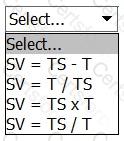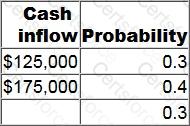A company is basing its budget on predicted sales of one of its products. They have tasked you with forecasting the sales in year 2. The company has found that a fairly accurate prediction can be found when the trend
is calculated like so:
a = 10,000
b = 2,000
The sales of year 1 were affected by seasonal variation and were as follows:
Q1:12,500
Q2:14,200
Q3:15,400
Q4:19,650
You use a multiplicative model and round percentages to the nearest whole percent.
Select ALL the correct quarterly forecasts of year 2 from the list.
A time series (TS) is made up of two main components i.e. trend (T) and the seasonal variation (SV).
The equation that represents the seasonal variation under the additive model is:

A healthcare company specializes in hip, knee and shoulder replacement operations, known as surgical procedures. As well as providing these surgical procedures the company offers pre operation and post operation in-patient care, in a fully equipped hospital, for those patients who will be undergoing the surgical procedures.
Surgeons are paid a fixed fee for each surgical procedure they perform and an additional amount for any follow-up consultations. Post procedure follow-up consultations are only undertaken if there are any complications in relation to the surgical procedure. There is no additional fee charged to patients for any follow up consultations. All other staff are paid annual salaries.
The company’s existing costing system uses a single overhead rate, based on revenue, to charge the costs of support activities to the procedures. Concern has been raised about the inaccuracy of procedure costs and the company’s accountant has initiated a project to implement an activity-based costing (ABC) system. The project team has collected the following data on each of the procedures.

Calculate the profit per procedure for each of the three procedures using activity-based costing.
What was the profit for the knee procedure, using ABC costing?
A company is choosing between three projects, Project P, Project Q and Project R using minimax regret as the criterion for the decision. The outcome from each project is dependent on future economic growth. If this is strong, returns will be P $5,000, Q $6,500 and R $7,200. If it is weak, returns will be P $3,500, Q $4,800 and R $4,200.
Place the correct figures into the table to show the maximum regret for each project.

Sales volumes reported for the latest period are used by managers as the basis to forecast sales for the forthcoming period. The forecasts are compared with the budgeted sales and plans are adjusted to ensure that the budgeted sales are achieved.
This is an example of:
JDM is considering whether to go ahead with the launch of a new product. Profit from the new product is dependent on the level of demand.
The following table shows the estimated profits and their respective probabilities at different levels of demand.
The company could still cancel the launch of the product but would incur a cost of $7,000.

What is the maximum amount that the company should pay for perfect information about demand for the product?
A project has an expected value of $165,250.
The estimates of cash inflows and their probabilities are:

What is the missing cash inflow?
Give your answer as a whole number.
RS is a travel company providing daily tours of a major European capital city. The market is highly competitive and RS has commissioned some market research to help with the pricing decision for a new tour. The research identified the probability of three possible market conditions and the number of tickets that would be sold each day at three different price levels.

Demonstrate, using a decision tree and based on expected value, which ticket price RS should choose.
According to a decision tree forecasting, there are three possible outcomes of a project requiring £10,000 capital investment. They are (along with probability of occurring): £20,000 in revenue (45%), £35,000 (15%),
£10,000 (30%) and -£6,000 (10%).
However, choosing another project (2) requiring the same investment would give us £12,000 and choosing project 3 would give us a 90% chance of generating revenues of £15,000 but a 5% chance of revenues of £0.
Project 4 is wildly ambitious and boasts an unlikely (5% chance) of generating revenues of £100,000. There is a 10% probability of negative revenues.
Which is the risk averse investor more likely to take?
Project 1
Project 2
Project 3
Project 4
A company is forecasting its revenue for May and has established that sales will be either high, medium or low. The expected value of sales revenue for May has been calculated as $160,000. The following table includes data which relate to the potential sales in May.
Revenue Probability Expected Value
High $250,000 0.2 C
Medium A 0.5 D
Low $100,000 B $30,000
Place the figures given in to the spaces marked with the letters A, B, C and D, to complete the above table.
